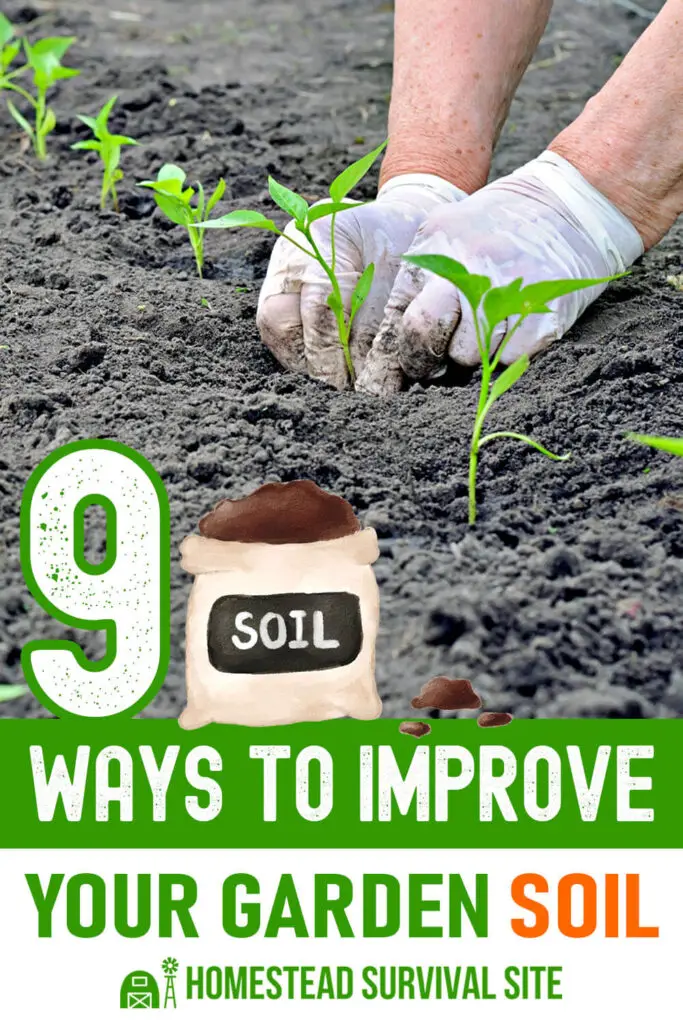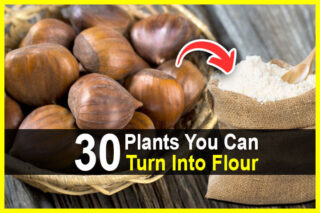Estimated reading time: 8 minutes
Growing a bountiful harvest begins with one simple yet extremely important step, regardless of where you live or what you're planting: soil quality. There are many ways to enhance the dirt you'll be planting your seeds in, none of which cost much money or time.
Soil is a mixture of air, water, mineral particles, and dead organic material. The amount of those components in every handful of dirt determine the founding blocks of the soil structure and what will likely grow in the garden plot.
Want to save this post for later? Click Here to Pin It on Pinterest!
Getting to Know Your Soil
Before you can start improving your soil, you need to find out what it's lacking or what it has an overabundance of. The soil and water conservation agencies in most counties will conduct soil sample testing free of charge, or you can follow a few simple steps to test your soil at home.
Discovering the soil pH content will lead to a better understanding of what vital minerals will be present around the roots of your crops. The make-up of the sand, clay, silt, and organic matter in the soil determine both its acidity (pH level) and overall texture.
Sand is the largest type of matter in soil. The round nature of sand particles permits more space to appear in between each grain. When an area of soil has a high sand content, both water and essential nutrients will drain through it far more quickly. Crops growing in this type of soil generally need more fertilizer and water to survive.
Silt is comprised of both mineral and rock particles, and it's the medium sized component found in soil. Silt stems from feldspar and quartz.
Clay compounds are the smallest matter in any soil structure. The particles are both very small and flat, causing them to form together in a substantially close manner. Soil with a high clay count usually contains an abundance of nutrients, but it stores water so well that it can kill the plants growing in it. Another downfall associated with clay soil is how slowly is warms during the initial phases of the spring growing season.
When the right combinations of all three components are present in a patch of soil, both air and water flow through properly, trapping needed nutrients inside – such a beneficial mixture is often referred to a loam.
Soil Testing
Determining the pH Level
- Dig up 1 cup of soil from your gardening plot and pour equal amounts of it into separate bowls.
- Pour in ½ cup of distilled white vinegar in one cup. If the mixture fizzes, the soil has a high alkaline content and a pH level above 7 up to an 8.
- If the soil does not fizz, pour some distilled water into the other cup of soil, just enough to make it muddy.
- Remove 2 teaspoons of the muddy dirt and mix it with ½ cup of baking soda. If the soil fizzes this time, the dirt is acidic and has a pH balance of 5 or 6.
- Should the soil not have any reaction during either stage of the soil test, it is likely top quality soil with a neutral pH balance at a steady level 7.
If the soil test reveals that the soil has a high alkaline count (pH level above 7) you must either only grow plants that thrive in such conditions, or take steps to lower the acidic level by adding organic matter, like peat moss, leaf mulch, compost, or pine needles, to the dirt in the growing area.
Using organic material to move the pH level to a more neutral level changes the alkaline and acidic content in the soil. Organic material works as a type of buffer inside the soil and prevents it from becoming too alkaline or acidic. Compost or a mulch comprised of peat moss, sawdust, oak leaves, and pine needles should help reduce the alkalinity in the soil.
Material from a fully processed compost pile should have an almost neutral pH balance. Putting regular buckets of composted material onto the soil usually corrects even severe pH balance issues over time. Achieving a pH level of 6.5 to 6.8 in your soil should greatly improve your harvest considerably, but this will be a gradual process that may take up to two growing seasons to complete.
Soil that has a lower than 6.5 pH balance is typically far too acidic for most plants. Sprinkling agricultural lime on acidic soil will infuse the dirt with more manganese and help increase the pH level. The lime should be applied after the harvest in preparation for the next growing season because it commonly takes a few months to cause a change to the pH level.
If you have a wood stove or a fireplace, save your wood ash. When sprinkled in the garden, is raises the pH level more quickly than lime and also infuses more trace minerals and potassium into the soil.
Raising the pH Level
To increase the pH level by approximately one point…
- Sandy Soil: Apply approximately four pounds of lime per every 100 square feet.
- Clay Soil: Sprinkle up to 10 pounds of lime every 100 square feet.
- Loam: Add up to eight pounds of lime per 100 square feet.
Lowering the pH Level
To decrease the pH level by approximately one point…
- Sandy Soil: Add up to 1 pound of sulfur per 100 square feet.
- Clay Soil: Add up to 2 pounds of sulfur per 100 square feet.
- Loam: Add up one-and-a-half pounds of sulfur per every 100 square feet of growing space.
Determining the Type of Soil
- Fill a pint Mason jar halfway with soil from your garden plot.
- Pour water into the jar until it is filled to the lip.
- Put on the lid and ring and shake vigorously for a few minutes to thoroughly mix all of the particles together until they are suspended inside the jar.
- Place the Mason jar in a level space for at least two hours to give the soil particles time to settle and separate into three layers: silt, sand, and clay.
- When the soil particles settle, the bottom layer will be comprised of the heaviest parts, tiny rocks and sand. The middle layer will contain the clay particles and the top layer will hold the silt.
To determine the soil content and type, pay close attention to the color inside the jar.
- If the contents are dark, it has a high organic composition and will warm well in the Spring.
- If the color is light, it has a smaller percentage of organic matter.
Next, determine what percentage of the jar each layer comprises.
- If the soil appears to be approximately 40 percent silt, 20 percent clay, and 40 percent sand, the soil is loam quality and does not require a pH count adjustment.
- If the jar layers are 60 percent silt, 30 percent clay, and only 10 percent sand, you have silty clay soil.
- If they soil layers are 65 percent silt, 15 percent clay, and 20 percent sand, silty soil is in your garden.
- If the soil layers in the jar are 65 percent sand, 15 percent clay, and 20 percent silt, you have sandy soil.
9 Ways to Improve Your Soil
We'll go over three treatments for each type of soil.
Sandy Soil Treatments
- Apply topically or till the growing plot and work in up to 5 inches or processed compost (dried manure compost preferably) and organic matter.
- Plant cover crops that infuse more organic matter into the soil: crimson clover, bell beans, Austrian winter peas, sweet clover, mustard, red or white oats, cereal rye, canola rape seed, buckwheat, black-eyed peas, Japanese millet, and soybeans.
- Mulch around the base of the garden plants with straw, hay, bark, or wood chips – or a mixture of them during various times of the year.
Clay Soil Treatments
- Add up to four inches of organic matter into tilled soil or on top of the soil, but do it in the fall if possible. The organic material will need time to treat the soil long before the spring growing season begins.
- Keep both manual spading and tilling to a minimum when working on treated clay soil.
- Plant cover crops that will infuse the topsoil with nutrients from the subsoil layer to help break up the highly compact clay layer. Recommended cover crops for clay soil include fava beans, buckwheat, alfalfa, and winter wheat.
Silt Soil Treatments
- Infuse 1 to 2 inches of organic material to the gardening plot on an annual basis. This can be mixed in during the tilling process (ideally) or placed on top of the ground. If the silt content is exceptionally high, focus on adding organic material only to the topsoil to prevent surface crusting.
- Reduce tilling in the garden plot, or even walking through it, as much as possible to prevent compacting of the soil. When dealing with silty soil, it is often best to grow in raised beds.
- During both the early spring before the growing season and in the fall after the harvest, put up to a 6-inch layer of mulch onto the topsoil. The best mulches for silty soil are comprised of hardwood bark, pine needles, fully processed compost, and straw.
Altering the nature of soil simply cannot be rushed. Doing too much too quickly will most likely result in an epic failure instead of a bountiful harvest, so be patient.
Like this post? Don't forget to Pin It on Pinterest!













Tara, this is an excellent article and I’d like your permission to reprint it in my Dying Time Newsletter, so my readers can benefit from your knowledge. I will give you full accreditation and post a link to your Homestead Survival website.
Tara is just one of our contributors, and yea she writes excellent articles! Sure, as long as you include a link back to the original article, that’s fine.
Thanks, Heidi, and tell Tara thanks as well.
too bad the article was missing, all that showed up when I clicked on the article was a request to sign up for email
I was accessing the Prepper Website
I accessed the article through the Prepper Website and it worked just fine for me–though as I recall I had to click on the “Go to article” link and then once at that page had to click on the “9 Ways to Make Your Garden Soil More Fertile” link to actually get to the article.
You can increase the amount of organic matter in your soil by adding compost, aged animal manures, green manures (cover crops), mulches, or peat moss. Because most soil life and plant roots are located in the top 6 inches of soil, concentrate on this upper layer.
I would love to recommend you this site: edenhorticulture.co.uk if you need some gardening supplies to hope this could help you have a nice day.